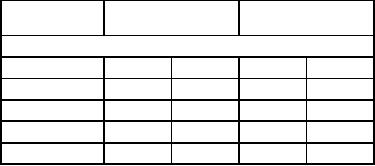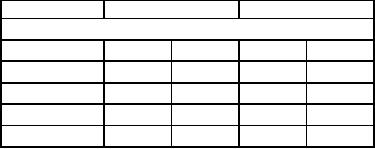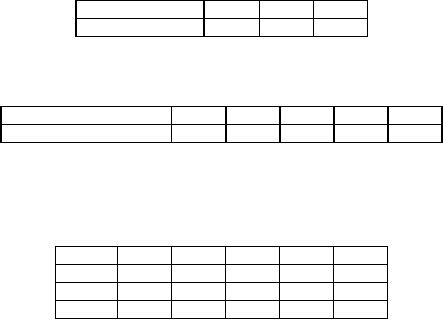 |
Operations
Research (MTH601)
164
Segment V:
Transportation Problems
Lectures
31- 35
164

Operations
Research (MTH601)
165
INTRODUCTION
Many
practical problems in operations
research can be broadly
formulated as linear
programming
problems,
for which the simplex this
is a general method and
cannot be used for specific
types of problems
like,
(i)
transportation
models,
(ii)
transshipment
models and
(iii)
the
assignment models.
The
above models are also
basically allocation models. We can adopt
the simplex technique to
solve
them,
but easier algorithms have
been developed for solution
of such problems. The
following sections
deal
with
the transportation problems
and their streamlined procedures
for solution.
TRANSPORTATION
MODEL
In
a transportation problem, we have
certain origins, which may
represent factories where we
produce
items
and supply a required
quantity of the products to a
certain number of destinations. This
must be done in
such
a way as to maximize the
profit or minimize the cost.
Thus we have the places of
production as origins and
the
places of supply as destinations.
Sometimes the origins and
destinations are also termed
as sources and
sinks.
To
illustrate a typical transportation
model, suppose m factories
supply certain items to
n
warehouses.
Let
factory i
(i =
1, 2, ..., m)
produce ai units and the
warehouse j
(j =
1, 2, ..., n)
requires bj units. Suppose
the
cost
of transportation from factory i to
warehouse j
is
cij. Let us define the
decision variables xij being the
amount
transported from the factory
i
to
the warehouse j.
Our objective is to find the
transportation pattern
that
will
minimize the total transportation
cost.
The
model of a transportation problem
can be represented in a concise
tabular form with all
the
relevant
parameters mentioned above.
See table 1
Table
1
Origins
Destinations
Available
(Factories)
(Warehouses)
1
2
........
n
1
c11
c12
c1n
a1
2
c21
c22
c2n
a2
...
...
...
...
...
m
cm1
cm2
cmn
am
Required
b1
b2
bn
The
pattern of distribution of items in the
form of transportation matrix is
separately given below in
table 2.
165

Operations
Research (MTH601)
166
Table
2
Origins
Destinations
Available
1
2
........
n
1
x11
x12
x1n
a1
2
x21
x22
x2n
a2
...
...
...
...
...
m
xm1
xm2
xmn
am
Required
b1
b2
bn
TRANSPORTATION
PROBLEM AS AN L.P
MODEL
The
transportation problem can be
represented mathematically as a linear
programming model.
The
objective
function in this problem is to minimize
the total transportation cost
given by
Z
= c11 x11 + c12x12 + ... + cmn
xmn
Subject
to the restrictions:
row
restrictions
x11 +
x12 +
+
x1n =
a1
x21 +
x22 +
+
x2n =
a2
xm1 +
xm2 +
+
xm1 =
am
Column
restrictions
x11 +
x21 +
+
xm1 =
b1
x12 +
x22 +
+
xm2 =
b2
x1n +
x2n +
+
xmn =
bn
and
x11 , x12 , ...
,
xmn ≥ 0
It
should be noted that the
model has feasible solutions
only if
m
n
a
+a +
+
am =
b1 +
b2 +
+ bn
∑
a1
=
∑ bj
or
1
2
i=1
j
=1
The
above is a mathematical formulation of a
transportation problem and we
can adopt the
linear
programming
technique with equality constraints.
Here the algebraic procedure
of the simplex method may
not
166

Operations
Research (MTH601)
167
be
the best method to solve
the problem and hence
more efficient and simpler
streamlined procedures
have
been
developed to solve transportation
problems.
Example
1 (Formulation
of a transportation problem)
A
company has plants located
at three places where the
production pattern is described in
the following table.
Plant
location
1
2
3
Production
(units)
40
70
90
The
potential demand at five
places has been estimated by
the marketing department and
is presented below.
Distribution
centre
1
2
3
4
5
Potential
demand (units)
30
40
60
40
60
The
cost of transportation from a
plant to the distribution centre
has been displayed in the
table
Table
3
Distribution
centers
Plant
1
2
3
4
5
1
20
25
27
20
15
2
18
21
22
24
20
3
19
17
20
18
19
Represent
the above data in a table to
represent a transportation
problem.
Solution:
In
this example the total
supply and the total
demand do not match as
supply is less than
demand.
Hence
a dummy row (dummy plant) is
introduced at a unit transportation
cost of 0. The following is
the tabular
representation
of the transportation
problem.
Note:
If
the total demand (requirements) is
less than the total supply
(availability), a dummy column
(dummy
destination)
is introduced with a unit
transportation cost of 0.
167
Table of Contents:
- Introduction:OR APPROACH TO PROBLEM SOLVING, Observation
- Introduction:Model Solution, Implementation of Results
- Introduction:USES OF OPERATIONS RESEARCH, Marketing, Personnel
- PERT / CPM:CONCEPT OF NETWORK, RULES FOR CONSTRUCTION OF NETWORK
- PERT / CPM:DUMMY ACTIVITIES, TO FIND THE CRITICAL PATH
- PERT / CPM:ALGORITHM FOR CRITICAL PATH, Free Slack
- PERT / CPM:Expected length of a critical path, Expected time and Critical path
- PERT / CPM:Expected time and Critical path
- PERT / CPM:RESOURCE SCHEDULING IN NETWORK
- PERT / CPM:Exercises
- Inventory Control:INVENTORY COSTS, INVENTORY MODELS (E.O.Q. MODELS)
- Inventory Control:Purchasing model with shortages
- Inventory Control:Manufacturing model with no shortages
- Inventory Control:Manufacturing model with shortages
- Inventory Control:ORDER QUANTITY WITH PRICE-BREAK
- Inventory Control:SOME DEFINITIONS, Computation of Safety Stock
- Linear Programming:Formulation of the Linear Programming Problem
- Linear Programming:Formulation of the Linear Programming Problem, Decision Variables
- Linear Programming:Model Constraints, Ingredients Mixing
- Linear Programming:VITAMIN CONTRIBUTION, Decision Variables
- Linear Programming:LINEAR PROGRAMMING PROBLEM
- Linear Programming:LIMITATIONS OF LINEAR PROGRAMMING
- Linear Programming:SOLUTION TO LINEAR PROGRAMMING PROBLEMS
- Linear Programming:SIMPLEX METHOD, Simplex Procedure
- Linear Programming:PRESENTATION IN TABULAR FORM - (SIMPLEX TABLE)
- Linear Programming:ARTIFICIAL VARIABLE TECHNIQUE
- Linear Programming:The Two Phase Method, First Iteration
- Linear Programming:VARIANTS OF THE SIMPLEX METHOD
- Linear Programming:Tie for the Leaving Basic Variable (Degeneracy)
- Linear Programming:Multiple or Alternative optimal Solutions
- Transportation Problems:TRANSPORTATION MODEL, Distribution centers
- Transportation Problems:FINDING AN INITIAL BASIC FEASIBLE SOLUTION
- Transportation Problems:MOVING TOWARDS OPTIMALITY
- Transportation Problems:DEGENERACY, Destination
- Transportation Problems:REVIEW QUESTIONS
- Assignment Problems:MATHEMATICAL FORMULATION OF THE PROBLEM
- Assignment Problems:SOLUTION OF AN ASSIGNMENT PROBLEM
- Queuing Theory:DEFINITION OF TERMS IN QUEUEING MODEL
- Queuing Theory:SINGLE-CHANNEL INFINITE-POPULATION MODEL
- Replacement Models:REPLACEMENT OF ITEMS WITH GRADUAL DETERIORATION
- Replacement Models:ITEMS DETERIORATING WITH TIME VALUE OF MONEY
- Dynamic Programming:FEATURES CHARECTERIZING DYNAMIC PROGRAMMING PROBLEMS
- Dynamic Programming:Analysis of the Result, One Stage Problem
- Miscellaneous:SEQUENCING, PROCESSING n JOBS THROUGH TWO MACHINES
- Miscellaneous:METHODS OF INTEGER PROGRAMMING SOLUTION